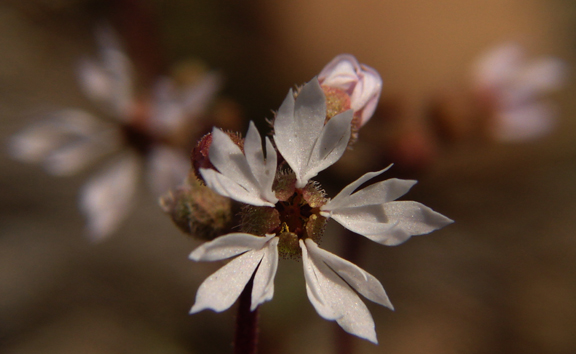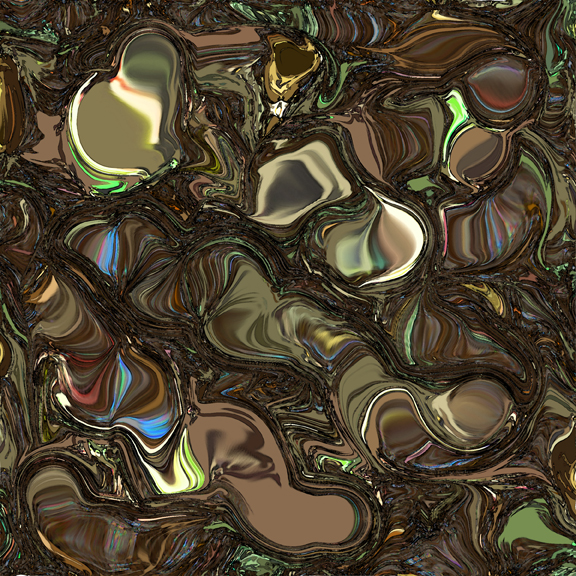And, of course, I need to make all of the usual disclaimers.
My photos are inadequate to express the biography of Lithophragma glabrum, the
internet information is bits and pieces of this and that and rather confused. Maybe
worse than usual.
My writing is even more chaotic than usual. But what the
hell. It all has to be done over next year ... and every year after, forever.
I may be beginning to be a little more forgiving of the
botanists. They assign this ‘plant description’ to an organism found all over
the west. But from the internet photographs it would seem that it looks,
superficially, quite different, observed only a couple of hundred miles apart.
z
1/14/2013 1:13:12 AM
Lithophragma glabrum, bulbous prairie flower
Saxifragaceae family.
Flora of North America says the classification of
Saxifragaceae has been varied and controversial. [The text descriptions reads,
once again, like ‘miscellaneous’.]
A Cornell
University
*
Lithophragma glabrum, bulbous prairie star [Lithophragma
bulbifera]
Paul Slichter says the USDA recently renamed this plant
‘Lithophragma glabrum’.
Searching USDA I get Lithophragma glabrum with Lithophragma
bulbiferum as a synonym. No mention of a recent name change.
Flora of North America says: “The
presence or absence of bulbils is the only feature distinguishing Lithophragma
glabrum and L. bulbiferum; for this reason L. bulbiferum is
not recog-nized in this treatment. Bulbil production is extremely variable
within the same clone in L. heterophyllum (R. L. Taylor 1965).”
*
Lithophragma glabrum is ‘viviparous’. [So are humans.] Viviparous:
2. Of plants. Producing bulbils or young plants instead of flowers. [L. glabrum
produces both bulbils and flowers.]
*
Paul Slichter has 4 internet sites for Lithophragma.
The first, listed, mentions 4 kinds of Lithophragma
‘Smooth Lithophragma’
photos of bulbils
Lithophragma parviflorum
Paul Slichter’s photos from The Columbia Gorge show almost
raspberry like bulbils that don’t show up in my photos. However there are brown
structures in my photos that might have been red bulbils earlier. Something
else to watch for in 2013.
Slichter lists L. bulbiferum as a ‘synonym’ and, in addition
he lists ‘Tellima bulbifera’.
He seems to include ‘rock star’, ‘fringecup’, ‘smooth
prairie star’ and ‘bulblet prairie star’ as common names.
He says the stems and leaves [presumably ‘stem-leaves’] are
typically ‘spreading glandular-hairy’ but may be ‘glabrous’, [not hairy,
smooth].
The base leaves are smooth to lightly haired.
Stem leaves are like base leaves but smaller.
The 2 to 5 stem leaves may bear several small reddish-purple
bulblets in their axils.
*
‘Bulbils’ or ‘bulblets’ are small bulbs. They develop in the
axils of leaves. They are found on onions and lilies as well. They ripen, fall
to the ground and take root reproducing ‘vegetatively’, presumably,
‘asexually’.
Apparently L. glabrum reproduces by seeds, as well as by
bulbils. The apparatus for both sexes are present.
*
INFLORESCENCE
Slichter calls the inflorescence ‘elongate and usually
compound with the lower flowers often replaced by bulblets …’
[The Slichter article on ‘smooth prairie stars’ … they have
bulblets … says ‘The inflorescence is usually a corymb or cluster of 2 to 5
flowers grouped closely near the tip of the stem.’]
Flora of North America says there are solitary flowers or ‘…
erect 2-5(-7) flowered racemes, often appearing corymbose.’ [Corymbose:
Resembling a corymb, a flat-topped inflorescence in which the flower stalks
grow upward from various levels on the main axis [stem] to approximately the
same height.]
The inflorescence is rarely branched unless the plant has
bulbils. The flowers are sometimes replaced by bulbils.
[[http://www.memidex.com/corymbose.
This is a nice collection of definitions of corymbose from different
dictionaries. Collins Dictionary adds that the oldest flowers are on the
periphery. I’m adding ‘memidex’ to my ‘favorites’ as my first stop for
definitions and spellings.]]
Montana Plant life says the flowers are 2 to 5 in ‘a
cluster’ that, early, is narrow and flat topped and later becomes more open and
elongate.
*
ROOTS
Wikipedia says it is a rhizomateous perennial herb.
Montana Plant Life says it rises from a slender rootstalk
with numerous rice-grain bulblets.
*
THE FLORA OF NORTH AMERICA
The Flora of North America has the most stuff, as usual,
and, it is, as usual, written in the most dense syntax, not always
decipherable, and impossibly opaque vocabulary.
The Lithophragma glabrum plants are often red and are
usually fragile.
The leaves are a basal rosette and cauline leaves. They seem
to say the cauline leaves are ‘3-lobed or –foliolate’. Perhaps the ‘minus sign’
says they are less than compound?
“Stipules large, not decurrent on petiole, (margins
fimbriate; …” [Decurrent: Having the leaf base extending down the stem below
the insertion. Decurrent leaves.] [Fimbriate: Having a border of hairs of
filiform processes.] [Filiform: Resembling a thread or filament.]
In writing of the pedicels they refer to its hypanthium. The
Pedicels are 3 to 4 times the length of the hypanthium. I don’t see a mention
of a hypanthium in other sources. Merriam-Webster on-line says: Hypanthium: An
enlargement of the floral receptacle bearing on its rim the stamens, petals and
sepals and often enlarging and surrounding the fruits, as rose hip.
Flora of North America says the Hypanthium is narrowly
campanulate [bell shaped] with acute or hemispheric base, elongating slightly
in fruit, throat open, length two times diameter. [It seems they are describing
what others call the calyx.]
The flowers are ‘pedicellate’ … they have pedicels … stems.
The sepals are erect in bud, widely spreading after
anthesis. [Anthesis: The period during which a flower is fully open and
functional. Greek: anth sis, flowering, from anthein, to bloom, from anthos,
flower.]
Petals are completely exserted. [Exserted: They stick out.
They protrude beyond an enclosing structure.]
The petals are narrowly clawed. [Claw, botany: The narrow,
stalk-like basal part of certain petals or sepals.]
The styles are slightly exserted in fruit.
The stigma papillae apical. [The Dictionary of Botany has:
Papilla, a projection from a cell, usually of the epidermis … often swollen and
covered with wax … So maybe these are the devices that trap pollen?]
**************
THE PHOTOS
I will compare L. glabrum to L. parviflora in 4 places,
buds, blossoms, basal and cauline leaves. The identification in the field can
be a little confusing but only a little. L. glabrum is somewhat earlier, or so
it seems in my experience. L. parviflora does ‘come on’ before L. glabrum ‘goes
off’. L. Parviflora looks a little larger and more ‘robust’.
Patches of Lithophragma glabrum, bulbous prairie star.
010-020
Young plants. The young plant in 030 is low on the right
hand side.
030-040
L. glabrum buds
050-060-070
L. parviflora buds for comparison. Notice the tapered look
to the base of the buds.
073-075
Blossoms of Lithophragma glabrum, white
The petals seem to be attached to the ‘hairy’ calyx [or is
it a hypanthium?] Perhaps the folded region at the base of the petals is a
‘claw’.
080-120
Blossoms of L. parviflora.
125-128
Blossoms of Lithophragma glabrum, pink
Notice that some blossoms have 5 petals and some have 6 petals
130-160
A close up of Lithophragma glabrum show the sexual apparatus
but I can only guess that the yellow is pollen. I need help with the other
structures.
Again, with good luck I will have better images in 2013
170
Lithophragma glabrum, side view
One may suppose the brown structures below blossom are
bulbils but they don’t seem to be in leaf axils. The certainly are not the
raspberry red structures in Paul Slichter’s photos.
180
The small collar at the union of pedicel and peduncle will
be a ‘decurrent stipule’.
Notice its fimbriate margins.
190
Back view
200
Glandular secretions
210
L. glabrum base leaves
220-230
L. parviflora base leaves
235
L. glabrum cauline leaves
238 – I thought those might be developing cauline leaves but
it looks like they have fimbriate margins. If, therefore, they are stipules,
where are the axils?
238-238-240
L. parviflora cauline leaves
260
L. glabrum, developing bulbils, maybe
270-310
L. glabrum, fading
320-340
There are 26 graphics files beyond this point. I can’t
apologize for them. Well. I won’t.
They are a progress through changes.
I started with a photograph of L. parviflora foliage and ran
graphics manipulations.
I’ve done a lot of this sort of thing over the years. Most
of the time I would be working toward symmetry. More recently I have developed
symmetry, then destroyed it.
In this progress I built a symmetry, destroyed it, and built
a new symmetry from the wreckage.
I hope some viewers share the pleasure I had in the work.
For the rest of you … if you hate it, don’t look at it. z
































































No comments:
Post a Comment